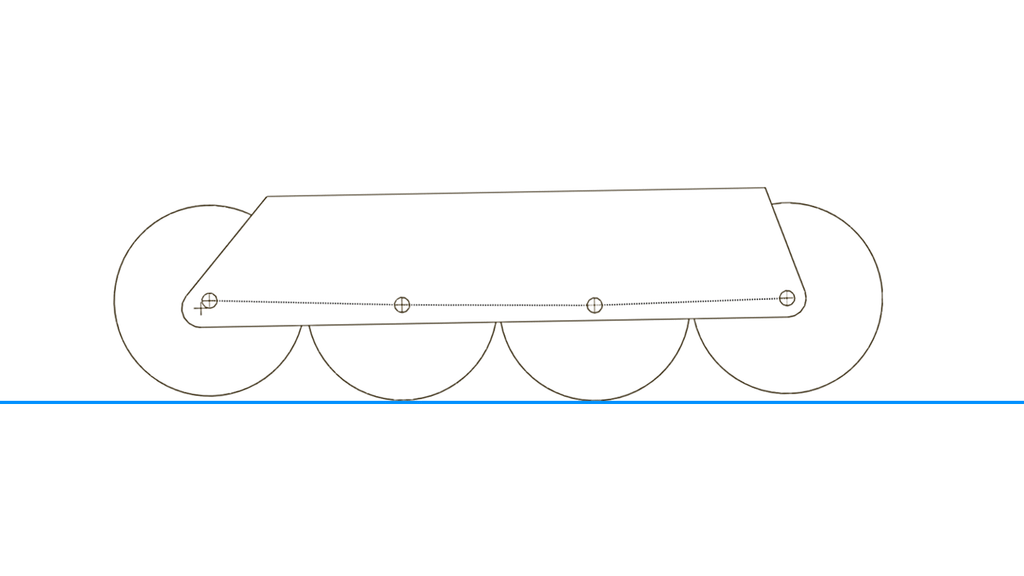Historically the term "banana rocker" has referred to a specific 2 mm rocker of the 1st and 4th wheels preferred by slalom skaters for increased maneuverability. The banana rocker is aptly named because the front and rear wheels are raised up relative to the ground and the resultant geometry resembles the curve of a banana. However, the amount of rocker of the 1st and 4th wheels can be any amount greater than zero, and does not need to be symmetrical. Therefore, in a general sense, any rocker design where the 1st and 4th wheels don't touch the ground is a variation of the classic banana rocker.
In some internet circles there exists the idea of a "3rd wheel down" rocker or "V-shaped" assymetric rocker where the 3rd wheel is the lowest, the 2nd and 4th wheels are raised up relative to the 3rd, and the 1st wheel is raised up relative to the 2nd. While a frame designer can certainly create rockers relative to the bottom edge of the frame, when the polyurethane hits the road (literally), the theoretical invention must ultimately confront reality. In use, the geometry of this kind of 4-wheel frame delivers a version of banana rocker as we will demonstrate below.
The diagram below presents a ficticious 4-wheel frame design where the wheels are raised (rockered) progressively from the 3rd wheel — the "3rd wheel down" rocker. For simplicity the top surface of the frame is shown as flat, but it could also have two interface surfaces like our Endless frames do (165 mm raised heel mount). Note how the bottom edge of the frame is parallel to the ground (represented by the blue line), and the 1st wheel is higher than the 2nd and 4th, which are higher than the 3rd. The absolute amount of rocker is exaggerated to make it easy to visualize:

In reality, we do not typically skate on just one wheel. At a minimum, two wheels must touch the ground. Three things occur when the 2nd and 3rd wheels touch the ground with the above design:
- The frame tilts forward, and thus gives the skate a forward lean relative to the mounting interface with the boot.
- The only wheels experiencing a rocker are wheels 1 and 4 — the same as the banana rockered frame.
- The bottom edge of the frame is no longer parallel with the ground.
In the diagram below one can see the forward tilt of the top surface of the frame, and how the only wheels not touching the ground are the 1st and 4th. While the bottom edge is no longer parallel with the ground, this merely affects aesthetics and not the performance of the skate.

If the boot has a flat UFS mounting interface the forward tilt of the frame can be a positive development, and give a more natural skating posture by creating a slight heel raise. However, in the case of a boot with a 165 mm raised heel mount like the FR1 or Twister Edge, the additional forward lean would be unwelcome and not very ergonomic as these kinds of boots already have sufficient heel raise built into them. A forward leaning posture on a raised heel boot is generally considered to be bad skating posture, as skating through the ball of the foot promotes instability, especially when turning. If one references the rockers of ice skates (both figure and hockey), the center section of the blade has the least amount of rocker and is generally where most of the weight is centered for stable skating. Similar to an ice skate, the Endless Balanced Rocker achieves a balance of stability and agility without destabilizing forward lean.
What happens if wheels 1 through 3 are collinear (all in a line) and not progressively rockered as in the diagram above? In this case the 1st wheel in addition to wheels 2 and 3 will be on the ground, and thus only the 4th wheel will be rockered up. This design configuration could also be perceived as a variation of banana rocker, albeit with a zero front wheel rocker. There's a good reason that ice skates never have rocker designs like this – they don't make much sense. A heel-only rocker would be the opposite of an ice figure skate rocker where the rear/center part of the blade is the flattest, and the rocker gets progressively greater towards the ball of the foot.
The animation below demonstrates how the "3rd wheel down" or "V-shaped" rocker is truly just another form of banana rocker as the frame tilts forward to represent the reality of wheels on the ground.

© 2020 Endless Blading Co.
